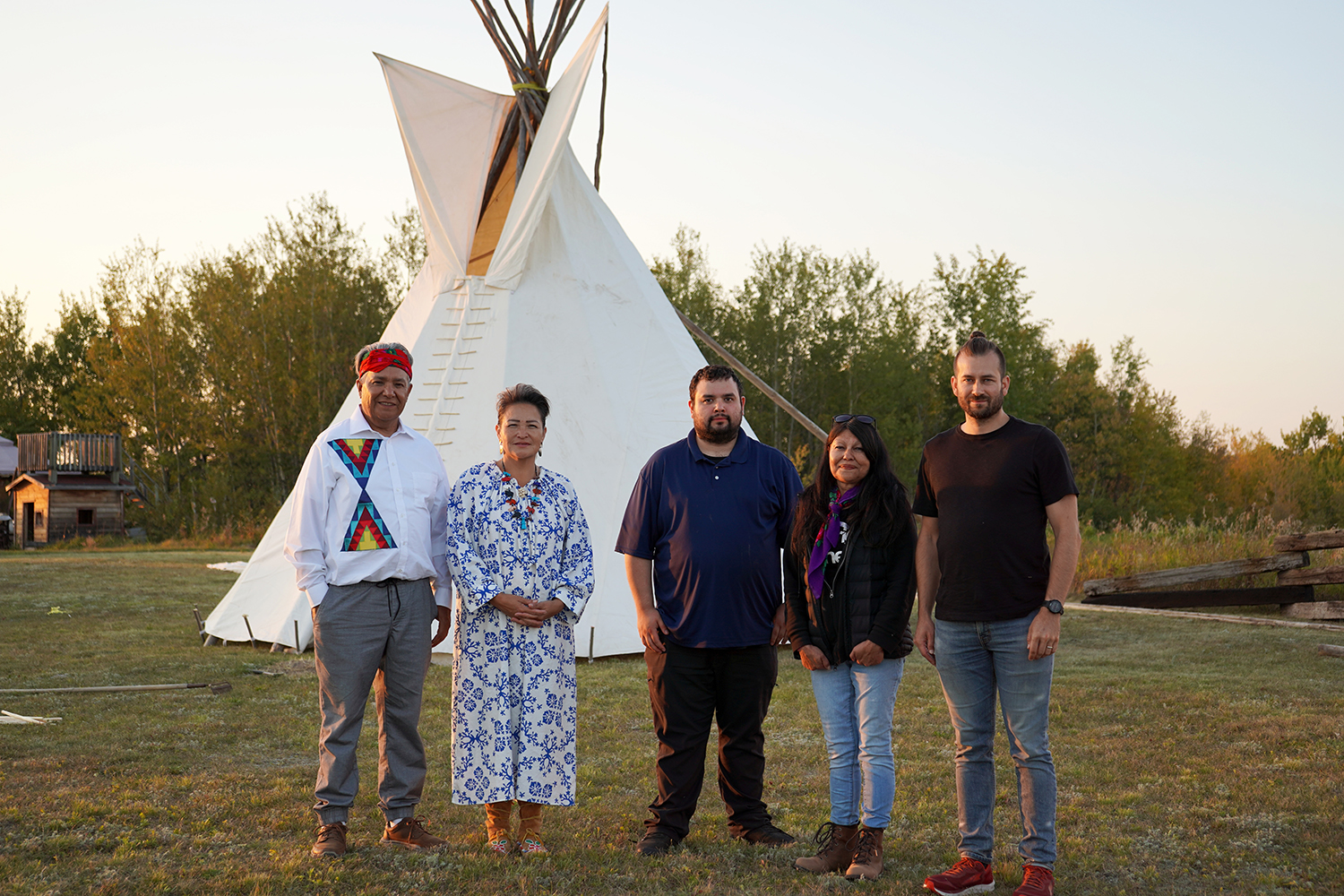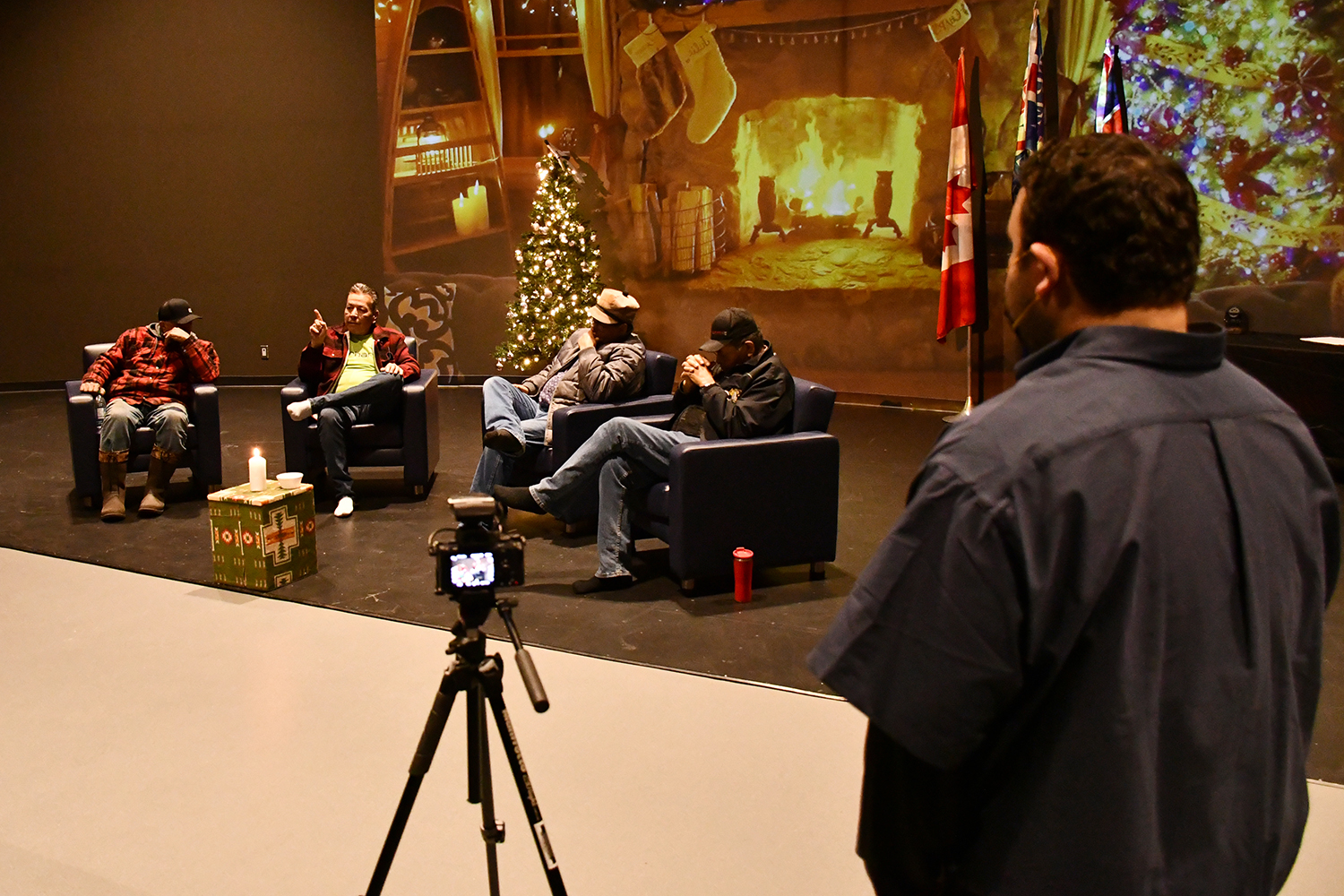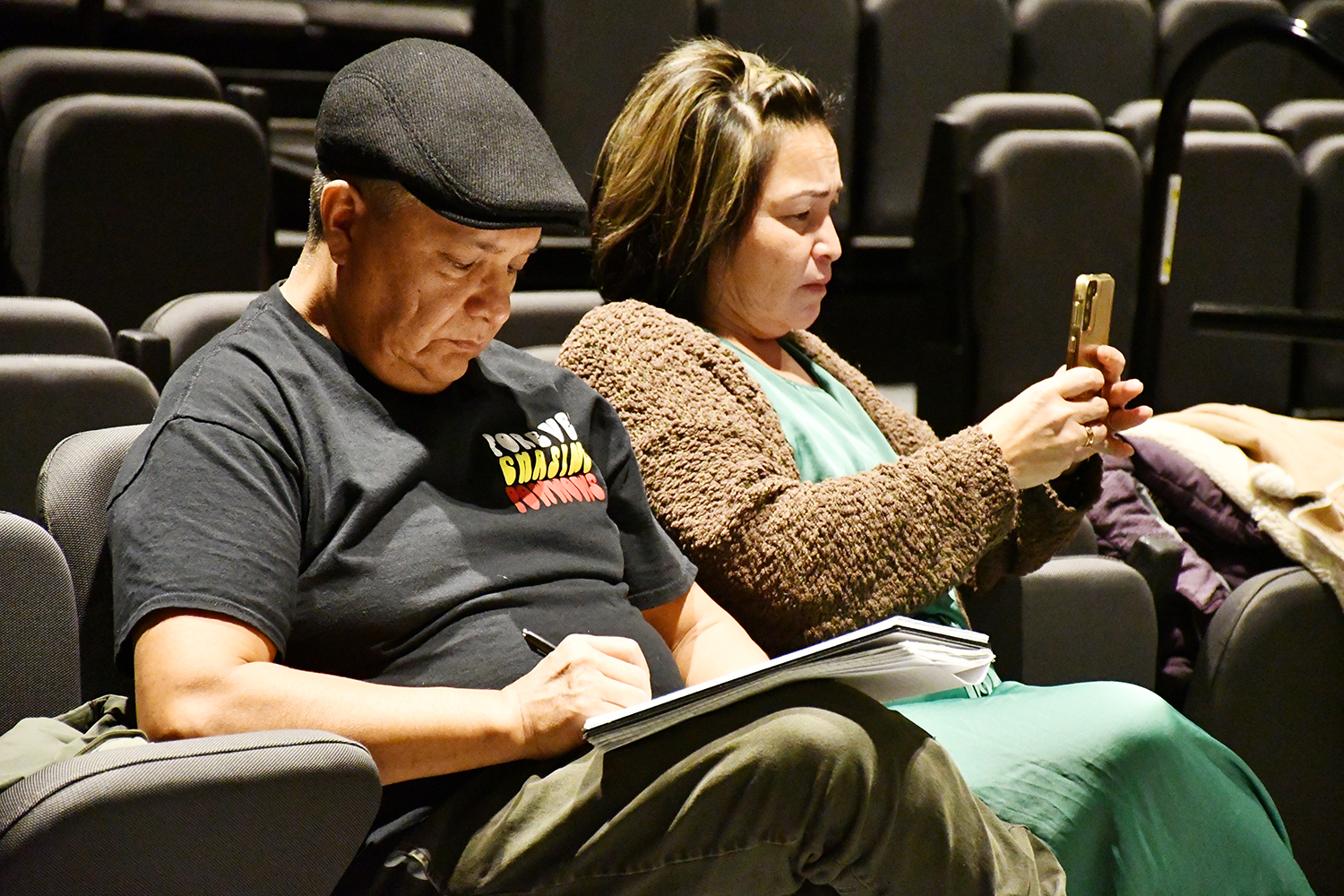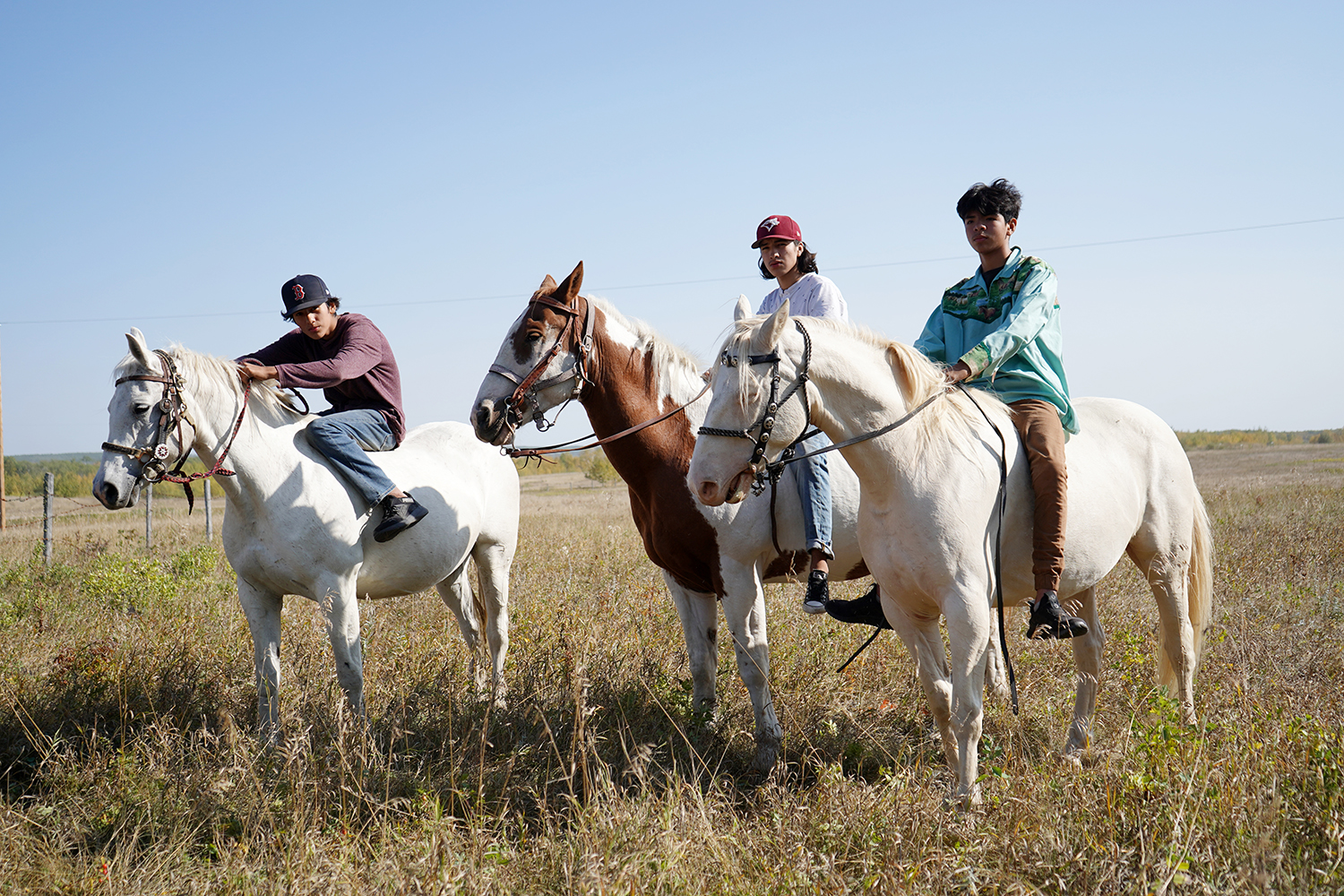
Pewaseskwan at USask supports Nehiyawak (Cree) language and culture revitalization on Saskatchewan First Nation
Nehiyawak (Cree) language echoes through the auditorium at Sakāskohc High School on Onion Lake Cree Nation (OLCN) on a cold December evening. Four male Elders sit in armchairs at the front of the auditorium taking turns sharing knowledge, memories, and language. Their stories are being recorded for others in the community to access and they will be archived for future generations.
By SARAH MACDONALD“A lot of Elders have stories that need to be known. I want [young people] to hear the stories so that they can change the way they are and [go] back to the way it was, the good life. Tonight was about trying to change the young generation of Cree to not be afraid to talk Cree. I’d like to see that Cree come back because it is important,” explained Willard Harper, following the recording.

Harper and the other Elders are participating in a community-based research project at OLCN that is supported by Pewaseskwan (the Indigenous Wellness Research Group) at the University of Saskatchewan (USask), co-lead by Dr. Alexandra King (MD) and Prof. Malcolm King (PhD), faculty in the College of Medicine. The research is part of a Canadian Institutes of Health Research-funded project, Miyo-pimâtisiwin, which loosely translates as “living the good life.” Working with Pewaseskwan, communities lead research based on Indigenous ways of knowing, being, and doing.
OLCN’s research, led by community member Dolores Pahtayken and her husband Ralph Morin, a member of Big River First Nation, focuses on revitalizing Cree language and ceremonies, which were lost under colonization, as a way to improve wellness.
OLCN straddles the border of Alberta and Saskatchewan about 50 kilometres north of Lloydminster, in Treaty 6 territory. Approximately 4,000 of its 6,500 members live on the reserve, and according to Pahtayken, there are at least 30 Elders who speak Cree and who have knowledge they want to preserve.
Bringing Cree back to community
With nearly 97,000 speakers, Cree is the most widely spoken Indigenous language in Canada, but due to the impact of residential schools, the Sixties Scoop and child apprehension into non-Indigenous care, many people do not speak it. In some communities, such as OLCN, important work is being done to preserve and promote the language. For Pahtayken and Morin, Cree is not just a collection of words and syntax; it holds their culture and is a key to improving the community’s wellness.

“Some of the language and how they speak is what we need to relearn as people, such as the behaviours and how to treat people. These stories were really about reminding people of the things that were practiced back in their day. These are the stories we need to get back to the people to have good health within the village, within the community,” explained Morin.
Back in the auditorium, Harper and the other Elders take turns speaking. Walter Pahtayken (Dolores’s father), Peter Chief, and Jeff Wastesicoot, an Elder from Pimicikamak Cree Nation in Treaty 5 (northern Manitoba) who shares his knowledge of language and ceremony with other Cree communities, are also on the stage. They listen attentively to each other, nodding occasionally to affirm what is being shared.
Wastesicoot explains the Cree names for different plants and animals. These words are not often used anymore but they spark memories for the other Elders.
Chief said Wastesicoot reminded him of days on the land with his Kokum (grandmother) and Mosum (grandfather) who raised him. He said he hopes these recordings will be there for his children and grandchildren and their generations so they can learn from him and the other Elders.
Walter Pahtayken, who spoke about the history of the community and the place names, agrees.
“The more I talk, the more I think about the past and how I grew up, how the Elders taught me. Hopefully in the future my grandkids might be able to listen and learn something,” he said, adding that through the language, they can learn Cree values about what is right and wrong.
Morin and Dolores Pahtayken say each Elder in the community has part of the entire story that they are trying to put together and document. Until now, there have been few opportunities for the Elders to share their knowledge.
Thanks to the collaboration with Pewaseskwan, the researchers at OLCN have the financial and structural support to carry out their research and bring the language back to community spaces so others can engage with it. They can pay honoraria and provide meals and traditional gifts, following Cree protocols.
Their work is also supported by another Pewaseskwan project, Achimok (“Tell your stories”), which makes audio and video recordings to create databases of communities’ knowledge and stories. A series of Elders’ talks, including the one at the high school, and some other community events are being recorded and saved in a database for future access and use. This way, the language and culture can live on.
“I am hearing such passion from Ralph and Delores about the importance of teaching language and language revitalization. It’s not just for people to learn it, but it’s for the teachings that are embedded within that way of thinking, that way of understanding the world, to affect people’s lives,” said Luke Heidebrecht, who leads Achimok.
Heidebrecht hopes that the stories, music, and other language sharing that is recorded will be used by people to support themselves in their own healing journeys.
Reclaiming Cree ceremonies
Another aspect of Dolores Pahtayken and Morin’s research is bringing back traditional Cree ceremonies to OLCN. Pahtayken said one of the reasons there are high rates of substance use in their community is because people feel spiritually lost.

In September, they hosted a Horse Dance ceremony at their home, attended by many people from the community. It honoured four young men, a couple of whom had been struggling with substance use and other challenges in their lives.
“These young fellows were struggling but you could see the pride and determination and discipline just going through that ceremony. You could hear and feel the people in the audience feel such pride for these boys and you could hear them hoping something like this continues,” explained Anne Mease, project lead for Miyo-pimâtisiwin.
That weekend they also held a Walking Out ceremony, when toddlers take their first steps on the earth. The children are led out of a tipi and walk in a circle in front of it pulling a bundle of items symbolic of their future selves. It’s a way for them to start learning the Cree way of life. According to Mease, this was the first time in anyone’s memory that the ceremony had been held at OLCN.
“Because of this research, two important ceremonies will now be revived,” she said.
The community hopes that reclaiming ceremonies like this and promoting the use of Cree will help ground people in their identities and help them with their substance use.
Dolores Pahtayken said the partnership with Pewaseskwan has allowed the community to do research and create programs and curriculum using Indigenous approaches rather than Western, colonized ways of thinking.
“We have many gaps in all the programming that we have right now. It’s not based on our philosophy. We’re excited to find a different way of thinking. What we’re seeing now is the development of a wellness concept based on the Nehiyo (Cree) philosophy,” she explained.
Doing research in a different way
The Pewaseskwan team members supporting OLCN’s research are guided by the community. In many ways, they are more like oskapews, Cree for “the ones who help or serve.”
Miyo-pimâtisiwin focuses on research that is led by community, with the academy and health-care system as the knowledge users. Leaders like Dolores Pahtayken and Morin can explore how language and ceremony can improve the wellness of their community and the Pewaseskwan team is there to support them.
For OLCN, even grant proposals and ethics applications were grounded in Cree language and methodologies. Mease ensured their documents reflected those needs while still being accessible to the people in the institution reviewing them.
For Mease, who grew up learning culture from Elders in her home community of Selkirk First Nation in Yukon, this research is important because it helps preserve Indigenous ways. As a researcher, she is integrated in the activities. She has witnessed the ceremonies and participated in preparing feasts.
“For me it’s like being home. I’m able to put my passion into the research. I’m right where I need to be,” said Mease.
The approach is also much more personal than with most research projects. Morin and Dolores Pahtayken welcome the Pewaseskwan team into their home and invite them to community events, such as a powwow to which Heidebrecht took his children. They want to know the researchers as people, not just as academics.
“For me it’s been an all-encompassing way of being involved in something. Research is not separated from family life and my beliefs and values. It’s integrated,” said Heidebrecht. “We want to bring ourselves into the work that we do. That leads to outcomes that are more grounded than imposed.”
Ultimately, the research is meant to have an impact on the community directly, rather than collect dust in a university office. It is grassroots research designed to help Indigenous people get their language and traditions back. As Morin puts it, it is research that “feeds the spirit of the Neyihaw people.”
